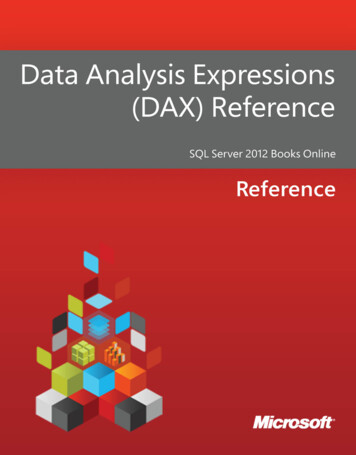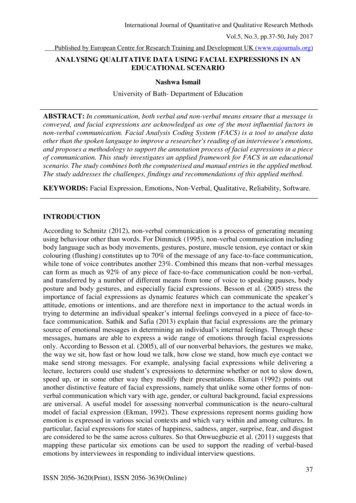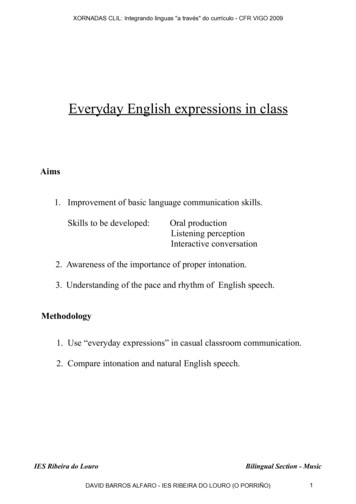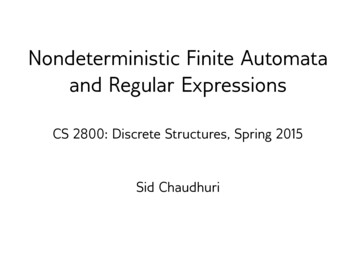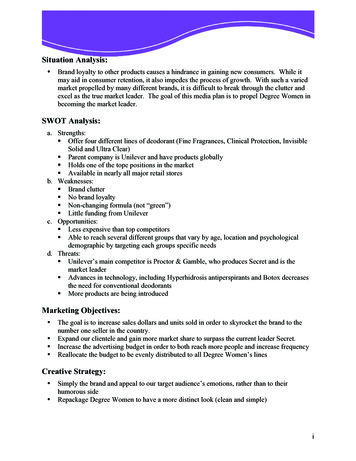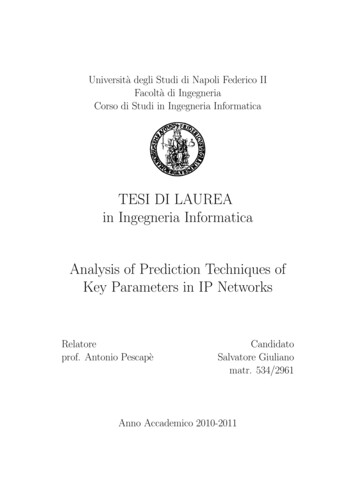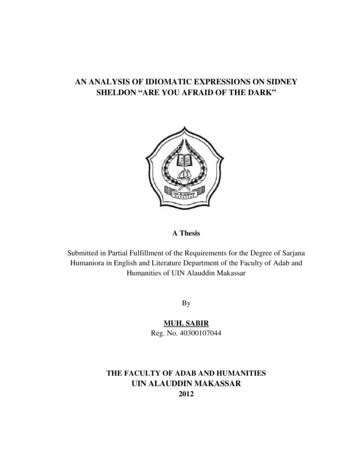
Transcription
AN ANALYSIS OF IDIOMATIC EXPRESSIONS ON SIDNEYSHELDON “ARE YOU AFRAID OF THE DARK”A ThesisSubmitted in Partial Fulfillment of the Requirements for the Degree of SarjanaHumaniora in English and Literature Department of the Faculty of Adab andHumanities of UIN Alauddin MakassarByMUH. SABIRReg. No. 40300107044THE FACULTY OF ADAB AND HUMANITIESUIN ALAUDDIN MAKASSAR2012
PERNYATAAN KEASLIAN SKRIPSIDengan penuh kesadaran, penyusun yang bertanda tangan di bawah inimenyatakan bahwa skripsi ini benar adalah hasil karya penyusun sendiri. Jikadikemudian hari terbukti bahwa ia merupakan duplikat, tiruan, plagiat, atau dibuatoleh orang lain, sebagian atau seluruhnya, maka skripsi dan gelar yang diperolehkarenanya batal demi hukum.Makassar, may 2012Penyusun,Muh. SabirNIM: 40300107044
PENGESAHAN SKRIPSISkripsi yang berjudul, “An Analysis of Idiomatic Expressions onSidney Sheldon Are Afraid of the Dark”, yang disusun oleh Muh Sabir, NIM:40300701044, Mahasiswa Jurusan Bahasa dan Sastra Inggris pada FakultasAdab dan Humaniora UIN Alauddin Makassar, telah diuji dan dipertahankandalam sidang munaqasyah yang diselenggarakan pada hari Jum’at, tanggal 15Mei 2012 M., bertepatan dengan 6 Jumadil Akhir 1433 H., dinyatakan telahdapat diterima sebagai salah satu syarat untuk memperoleh gelar SarjanaHumaniora dalam Ilmu Adab dan Humaniora, Jurusan Bahasa dan SastraInggris (dengan beberapa perbaikan).Makassar,15 Mei 2012 M.23 jumadil Akhir 1433 H.DEWAN PENGUJI:Ketua: Drs Abd. Rahman R., M. Ag.()Sekretaris: Dra. Susmihara, M.Pd.()Munaqisy I: Dr. H. Barsihannor, M. Ag.()Munaqisy II.Pembimbing I: Serliah Nur, S,Pd, M.Hum., M.Ed.(): Prof. Dr. Mardan, M.Ag.()Pembimbing II: Dr. Abd Muin, M.Hum.()Diketahui oleh:Dekan Fakultas Adab dan HumanioraUIN Alauddin Makassar,Prof. Dr. Mardan, M.Ag.NIP: 19591112 198903 1 001
APPROVAL SHEETTitle: “An Analysis of Idiomatic Expression on Sidney Sheldon’s Are YouAfraid of the Dark”Name: Muh. SabirReg. Number : 40300107044Program: English and Literature DepartmentMakassar, April 30th 2011SupervisorConsultant IConsultant IIProf. Dr. Mardan, M. AgNIP: 19591112 198903 1 001Dr. Abd. Muin, M.Hum.NIP: 19660102 199203 1 002Approved byThe Head of English and Literature DepartmentDr. Abd. Muin, M.Hum.NIP: 19660102 199203 1 002Acknowledged byThe Dean of Adab and Humanities Faculty ofUIN Alauddin MakassarProf. Dr. Mardan, M.Ag.NIP: 19591112 198903 1 001
ACKNOWLEDGMENTSFirst of all, the writer would like to thank to Allah SWT for His blessing,mercy, guidance and love given to the writer during his study at Adab andHumanities of UIN Alauddin Makassar. Shalawat and taslim are also addressed to thebeloved and chosen messenger our prophet Muhammad saw who has guided us fromthe darkness to the lightness.Then the writer would like to express his gratitude to his beloved parents(Alm) Muh. Ismail and Jubaedah Shaleh for providing support, understandingattitude, care, and patience that can never be repaid.Then, his greatest thanks is also addressed to the Rector of UIN AlauddinMakassar, Prof. Dr. H. Abd. Qadir Gassing, HT. MS., the Dean of Adab andHumanities Faculty, Prof. Dr. Mardan, M.Ag., the Head of English and LiteratureDepartment, Dr. Abd. Muin, M.Hum., and the secretary of English and LiteratureDepartment, Serliah Nur, S.Pd., M.Hum., M.Ed., for their help, support, suggestion,precious time, and administrative support.The writer would also like to express his thanks to both of his greatestconsultants, Prof . Dr. Mardan, M.Ag and Dr. Abd. Muin, M.Hum for their guidance,corrections, advice and suggestion since the preliminary until the completion of thethesis.
Then, the biggest thanks is addressed to all the lecturers of Adab andHumanities Faculty for their enlightenment, their advice and their knowledge toduring the academic years.The writer also extends his gratitude to Rini Rahmawati who always supportsand helps him whenever and wherever he needs.The writer says special thanks to his best friends A-Nthy Avicenna and Sarwofor their help.And the writer’s special thanks is also goes to all my beloved friends at UINalauddin specially at Adab and Humanities Faculty, at BSI 07, at Gazebo Ball UINCommunity, at KisSA, at English Zone, at HMI komisariat Adab, at KKN, at UMI, atUNHAS, at UIN Blogger Community, at Mindset English Center, and at AG.1 forbeing a nice person.The writer realizes that this thesis is still far for being perfect, so anyconstructive critics and suggestions from readers will be gladly accepted.Makassar, may 1st 2012the writerMuh. SabirReg. No. 40300107044
TABLE OF CONTENTSHALAMAN JUDUL . HALAMAN PERNYATAAN KEASLIAN SKRIPSIHALAMAN PENGESAHAN SKRIPSI . iii . . iiiAPPROVAL SHEET . ivACKNOWLEDGMENTS . vTABLE OF CONTENTS . . viiABSTRACT . . xCHAPTERIINTRODUCTION . . 1A. Background of Research . 1B. Problem Statements .3C. Objectives of Research .3D. Significance of Research . 3E. Scope of ResearchCHAPTERII . 4REVIEW OF LITERATURE . . 5A. Previous Findings . .5B. Semantic . . 6C. Phrase . 71. Definition of Phrase . . . 72. Kinds of Phrase . 8a. Noun Phrase . 9
b. Verb Phrase .9c. Adjective Phrase 10d. Adverb Phrase 10e. Prespositional Phrase 10D. Definition of Idiom . 11E. Kinds of Idiom 13a. Phrasal Verb 13b. Phrasal Prepositional Phrase 14c. Prepositional Phrase . 14d. Idiom with Verb as Keyword 15e. Idiom with Noun as Keyword 16f. Idiom with Adjective as Keyword . 16g. Idiomatic PairCHAPTERIII 17F. Definition of Novel 18G. Synopsis of Novel 19H. Autobiography 21METHODOLOGY OF RESEARCHA. Research MethodB. Data Source . . 23 . . 23 . . 231. Primary Data . 232. Secondary DataC. Instrument of Data Collection . 23 . 23
CHAPTERCHAPTERIVVD. Procedure of Data Collection . 23E. Technique of Data Analysis . 24FINDINGS AND DISCUSSION . 25A. Findings . . 25B. Discussion 26CONCLUSION AND SUGGESTIONS . . 48A. Conclusions . . 48B. Suggestions . . 49BIBLIOGRAPHY . 50APPENDICES . 52
ABSTRACTMuh. Sabir. (thesis) An Analysis of Idiomatic Expresssions in SidneySheldon’s “Are You Afraid of the Dark Novel. (Under guided by Mardan and Abd.Muin)This thesis is a research about the analysis of idiomatic expressions in thenovel Are You Afraid of the Dark by Sidney Sheldon. The objectives of this researchare (1) to find out the number of idiomatic expressions used by the author, (2) to findout the meaning of idiomatic expression that are used by the author in the novel AreYou Afraid of the Dark. The method used in this research is descriptive method. Incollecting data, the writer used note taking as his instrument, then the writer classifiedthe data using David Peaty’s theory and explain the meaning based on the context.In this research, the writer found that there are 7 types of idiomatic expressionused in the novel Are You Afraid of the Dark, they are: phrasal verb, phrasalprepositional phrase, prepositional phrase, idiom with verb as keyword, idiom withnoun as keyword, idiom with adjective as keyword and idiomatic pair. In addition, ininterpreting the meaning of idiom, we have to refer to the context.This implication of this research is to give more description to the readers,especially the student of English Literature Department about idiomatic expressionsin their meaning in novel, especially in the novel Are You Afraid of the Dark bySidney Sheldon.
CHAPTER IINTRODUCTIONA. BackgroundIt is known that English is an international means of communication. It isused to communicate with each other by people from different countries all over theworld. English is used as a formal communication tool in all international meeting.The most speakers in doing their business use English, for example internationaltrade, computer, book of science, technology and so on.In learning English, learners learn how to know the meaning of every singleword. They usually look up the dictionary to find the meaning of the words. InEnglish, there are words that cannot be found in the dictionary. There are phrases orsentences that cannot be explained by grammar theories. This special feature ofEnglish language is called Idiom.To master English, The learners have to know the element that build it up,such as grammar, vocabulary, and also the culture of people who speak English. Bymastering English, people easily express their ideas and thought in written or oralways in that language.The idiom in language regarded as a connotative manner to explain thegeneral thing. The usage of idiom in speech may increase the sense or strength ofwords than the ordinary formal words. In linguistics, the idiom is often considered as1
a language style which sometimes contradicts with the principles of grammar, andthis contradiction makes idiom unique.Keraf (1986:109) explains that to find out the meaning of idiom, it must belearned as the native speaker manner. It means the cultural aspect of idioms have tobe learned first. It will be impossible to look the meaning by the words contained inidiom.Kamuda (2008:1) states that the difficulties in translating idioms arise fromtwo different characteristics of language. The first is that language is constantlyevolving, and that new terms and phrases are frequently incorporated into languageto describe new ideas. This is especially true for technical fields, whereadvancements in technology necessitate new terminology and language. Secondly,the meaning of many idioms often does not correspond to that idiom's individualcomponents. For example, the idiomatic meaning of "can of worms" bears littleresemblance to a literal can of worms. This presents unique problems for translationsoftware that may operate on a word-to-word basis, as literal translations of thecomponent words often produce inaccurate or unintelligible target-language text.In some senses, idioms are the reflection of the environment, life, andhistorical culture of the native speakers and are closely associated with their innermost spirit and feelings. They are commonly used in all types of language, informaland formal, spoken and written.
From the background above, the researcher would like to observe idiomaticexpressions that occur in novel Are You Afraid of the Dark by Sidney Sheldon.Moreover, idioms are accepted as part of daily speech, we can find it in writing,reading, listening, and speaking. By knowing the idioms we can freely express ourthought, idea, and feeling in English.B. Problem StatementBased on the background above, the writer proposed the following researchquestions:1. What kinds of idiomatic expressions does the author use in the novel?2. What is the meaning of idiomatic expressions used by the author in thenovel Are You Afraid of the Dark?C. Objective of ResearchThe objectives of the research are:1. To find out the kinds of idiomatic expressions are used by the author.2. To find out the meaning of idioms that are used in Are You Afraid of theDark’s novel.D. Significant of ResearchThis research is expected to inform the students, especially foreign languagestudents that learning English can be done by read a novel or other fun activities. Thisresearch is also expected to give advantages for English novel’s reader to understandthe idioms that may occur in a novel, not only in novel Are You Afraid of the Dark.
Besides, this research can also be used in English class, especially in relation to theteaching of idioms.For other writers that who are interested in analyzing idioms, this research canbe a reference.E. Scope of ResearchThe analysis of this research is limited on the idioms which are in form ofphrases in the novel Are You Afraid of the Dark by Sidney Sheldon.
CHAPTER IIREVIEW OF RELATED LITERATUREA. Previous FindingSentong (2007) in his thesis “English Idiomatic Expressions in TheirIndonesian Translation in Novel Kidnapped by Robert Stevenson”. He analyzed thekinds of idioms in Kidnapped and found that idiom as expression which has meaningdifferent from individual of its part or component. These can be solved by finding anequivalent idiomatic in Indonesian translation. And kinds of idiom that used verymuch in the novel Kidnapped were phrasal verb without object (run away, look up,wake up. call up, pull over, put away, run down, watch out, light up, pick up, comeup), separable phrasal verb (take off, turn out, carry over, look out), inseparablephrasal verb ( set off, look after, took turn, turn round, come forward, come from, sitdown, look for).Fadhilah (2006) in his thesis “A Study on Idioms with Magical Terminologyin Harry Potter and Goblet of Fire”. His study focused to analyze the comparisonbetween real idioms and idioms with magical terminology in the novel Harry potterand The Goblet of Fire. He described the function of the idioms with magicalterminology was building the story. He found that the idioms with magicalterminology have functions to bring the reader to believe that the world of magic doesexist as they even has own language and culture.5
The similarity of this research with the previous finding is our research talkingabout idiom. But different from Sentong who analyzed idiom in their Indonesiantranslation and Fadhilah who compared real idiom with idiom with magicalterminology, this research will explain kinds of idiom and explain the meaningaccording to the context and story in the novel Are You Afraid of the Dark.B. SemanticSemantics is the study of word meaning and sente
collecting data, the writer used note taking as his instrument, then the writer classified the data using David Peaty’s theory and explain the meaning based on the context. In this research, the writer found that there are 7 types of idiomatic expression used in the novel Are You Afraid of
